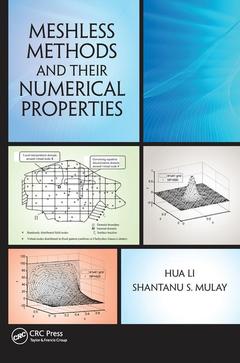Description
Meshless Methods and Their Numerical Properties
Authors: Li Hua, Mulay Shantanu S.
Language: English
Subjects for Meshless Methods and Their Numerical Properties:
Keywords
Field Nodes; Virtual Nodes; element; Meshless Methods; free; DQ Method; galerkin; Meshless Local Petrov Galerkin Method; point; SPH Method; interpolation; Local High Gradient; local; Local Weak Form; petrov; Cosine Distribution; weak; Shape Functions; form; Element Free Galerkin Method; diffuse; MLS Approximation; Computational Mechanics; Semi-infinite Plate; Local Support Domain; Wave Equation; DC Method; Global Error Norm; Transient Heat Conduction Equation; Order Monomials; Mechanical Equilibrium Equations; Adaptive Refinement; Collocation Points; Schur Polynomials; Delta Function Property
Publication date: 04-2017
· 15.6x23.4 cm · Paperback
Publication date: 02-2013
· 15.6x23.4 cm · Paperback
Description
/li>Contents
/li>Readership
/li>Biography
/li>
Meshless, or meshfree methods, which overcome many of the limitations of the finite element method, have achieved significant progress in numerical computations of a wide range of engineering problems. A comprehensive introduction to meshless methods, Meshless Methods and Their Numerical Properties gives complete mathematical formulations for the most important and classical methods, as well as several methods recently developed by the authors. This book also offers a rigorous mathematical treatment of their numerical properties?including consistency, convergence, stability, and adaptivity?to help you choose the method that is best suited for your needs.
Get Guidance for Developing and Testing Meshless Methods
Developing a broad framework to study the numerical computational characteristics of meshless methods, the book presents consistency, convergence, stability, and adaptive analyses to offer guidance for developing and testing a particular meshless method. The authors demonstrate the numerical properties by solving several differential equations, which offer a clearer understanding of the concepts. They also explain the difference between the finite element and meshless methods.
Explore Engineering Applications of Meshless Methods
The book examines how meshless methods can be used to solve complex engineering problems with lower computational cost, higher accuracy, easier construction of higher-order shape functions, and easier handling of large deformation and nonlinear problems. The numerical examples include engineering problems such as the CAD design of MEMS devices, nonlinear fluid-structure analysis of near-bed submarine pipelines, and two-dimensional multiphysics simulation of pH-sensitive hydrogels. Appendices supply useful template functions, flowcharts, and data structures to assist you in implementing meshless methods.
Choose the Best Method for a Particular Problem
Providing insight into the special features and intricacies of meshless methods, this is a valuable reference for anyone developing new high-performance numerical methods or working on the modelling and simulation of practical engineering problems. It guides you in comparing and verifying meshless methods so that you can more confidently select the best method to solve a particular problem.
Introduction. Formulation of Classical Meshless Methods. Recent Development of Meshless Methods. Convergence and Consistency Analyses. Stability Analyses. Adaptive Analysis. Engineering Applications. Appendices. Index.
Dr. Hua Li is currently an assistant professor at the School of Mechanical and Aerospace Engineering at Nanyang Technological University in Singapore. His research interests include the modeling and simulation of MEMS, focusing on the use of smart hydrogels in BioMEMS applications; the development of advanced numerical methodologies; and the dynamics of high-speed rotating shell structures. He has authored or co-authored several books and book chapters, as well as more than 110 articles published in top international peer-reviewed journals. His research has been extensively funded by agencies and industries and he acted as the principal investigator of a computational BioMEMS project awarded under A*STAR’s Strategic Research Programme in MEMS.
Dr. Shantanu S. Mulay currently works as a postdoctoral associate with Professor Rohan Abeyaratne of Massachusetts Institute of Technology as part of the Singapore–MIT Alliance for Research and Technology (SMART). Before joining Nanyang Technological University (NTU), Dr. Mulay worked in product enhancement of DMU (CATIA workbench) and the development of NISA (FEM product), where he gained exposure to a variety of areas such as the development of CAD translators, computational geometry, and handling user interfaces of FEM products. During his Ph.D. program at NTU, Dr. Mulay worked extensively in the field of computational mechanics and developed a meshless random differential quadrature (RDQ) method.




